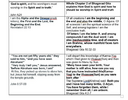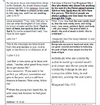You haven’t shown this at all, merely claimed this is the case without any documentation or references to sources. The story of Krishna is vastly different than the one of Jesus. Here’s a few examples.
Krishna wasn’t crucified but was killed in a hunting accident. Here’s the
excerpt from the actual story from Mahabharata (Book 16: Mausala Parva):
“The hunter, mistaking [Krishna]…for a deer, pierced him at the heel with a shaft and quickly came to that spot for capturing his prey. Coming up, Jara [the hunter] beheld a man dressed in yellow robes, rapt in Yoga and endued with many arms. Regarding himself an offender, and filled with fear, he touched the feet of [Krishna, who] comforted him and then ascended upwards…When he reached Heaven [he] met the deities…”
Krishna was also born in a prison, killed demons, had several wives, is an avatar of Lord Vishnu, never promised Heaven to anyone or asked anyone to believe in Him, was a warrior, stole milk and butter, etc.
Here are a few more misconceptions below.
- Christ is a form of the name Krishna.” No etymological connection between “Krishna” and “Christ” actually exists. Christ (christos) is the Greek equivalent of messiah (Hebrew mashiach). Both mean, “anointed one.” Krishna is an unrelated personal name, which derives from a Sanskrit term meaning “black, dark, dark-blue.”2
- “Krishna was born of a virgin.” This is a popular claim, sometimes made by atheists,3 but also by those who profess to be Christian.4 Hindu texts make it clear that his mother Devaki had already conceived seven other sons, the first six of whom were executed by the evil prince Kamsa after their births.5 Matthew states that the chaste Mary fulfills an ancient prediction of the prophet Isaiah (Matthew 1:23; cf. Isaiah 7:14).
- “Both men were born in a manger.” Contrary to songs sung at Christmastime, Jesus was not born in a manger, but rather was laid there after His birth (Luke 2:7). The Hindu text indicates that Krishna was born in a prison cell where Kamsa had imprisoned his sister Devaki and her husband Vasudeva when he learned that the couple’s eighth child (Krishna) was destined to kill him.6
- “Krishna was born on December 25, like Jesus.” Sources differ on the exact day of Krishna’s birth, which is often recognized as having occurred in the month of July. Hindus celebrate the birth of Krishna in the month of Bhadrapada (August/September). The Bible does not give a date for the birth of Jesus, which does not appear to have occurred at any time during the winter. Historian Andrew McGowan points out that the second-century author Clement of Alexandria identified several possible dates for the birth of Christ debated during his day, but December 25 is nowhere among his suggestions.7 None of the earliest estimates indicates Christ was born in December.
- “Krishna died at age thirty.” Although Jesus died in his early thirties, Krishna lived a much longer life. Common estimates place Krishna’s age at death somewhere around 100 years. A 2004 article in the Times of India reported Hindu scholars calculated that Krishna died at the age of 125.8
- “Krishna died by crucifixion.” Crucifixion appears nowhere in the Hindu texts. Krishna died after a hunter named Jara shot him in the sole of his foot with a poisoned arrow after mistaking him for a deer.9 Kersey Graves infamously claimed Krishna was crucified between two thieves, that darkness attended the event, and that he gives up the ghost and descends into hell,10 details he—or a source he used—invented out of whole cloth.
- “Krishna resurrected after three days.” After his death, Krishna’s spirit appears almost immediately.11 Being liberated from his physical body—or abandoning it—his spirit returns to the realm of the divine. Hindu pilgrims today still visit Dehotsarga (literally, where Krishna “gave up his body”),12 where they believe Krishna died. Jesus was buried in a newly cut rock tomb and later experienced a bodily resurrection that serves as a prototype for believers (1 Corinthians 15:20, 42-44). The Hindu view of Krishna’s death is much closer to Neo-Platonic philosophy than it is to Christianity.
A popular author who made similar claims to those above is the late Dorothy M. Murdock (also known by her pseudonym “Acharya S”). Her book
Suns of God: Krishna, Buddha and Christ Unveiled includes a litany of supposed parallels between Christian and Hindu beliefs. Although her work is hailed by her uncritical supporters and other non-specialists as a work of unparalleled scholarship, scholars dismiss her work as the stuff of crass invention. When asked about the supposed crucifixion of Krishna, Dr. Edwin Bryant, professor of Hinduism at Rutgers University, stated, “That is absolute and complete non-sense. There is absolutely no mention anywhere which alludes to a crucifixion.”
13 Murdock also claims that a number of other Hindu gods were depicted as crucified. Bryant again responded, “There are absolutely no Indian gods portrayed as crucified…. If someone is going to go on the air and make statements about religious tradition, they should at least read a religion 101 course.”
14
A common problem found in the work of militant critics is the failure to adequately understand the beliefs of the religions they oppose. Critics can be inexcusably careless in their descriptions, making ancient religions appear more similar than they really are. This is often done by describing non-Christian elements of other religions using Christian vocabulary, and then marveling at the similarities between the two. In some cases (especially authors from the 19th and early 20th centuries), these parallels were made using vague interpretations, supported by evidence which was poorly understood and likely fabricated.
Despite claims to the contrary, the story of Christ in no way plagiarizes the story of Krishna. To argue otherwise is to twist and distort the teachings of both Christianity and Hinduism.”
Source



